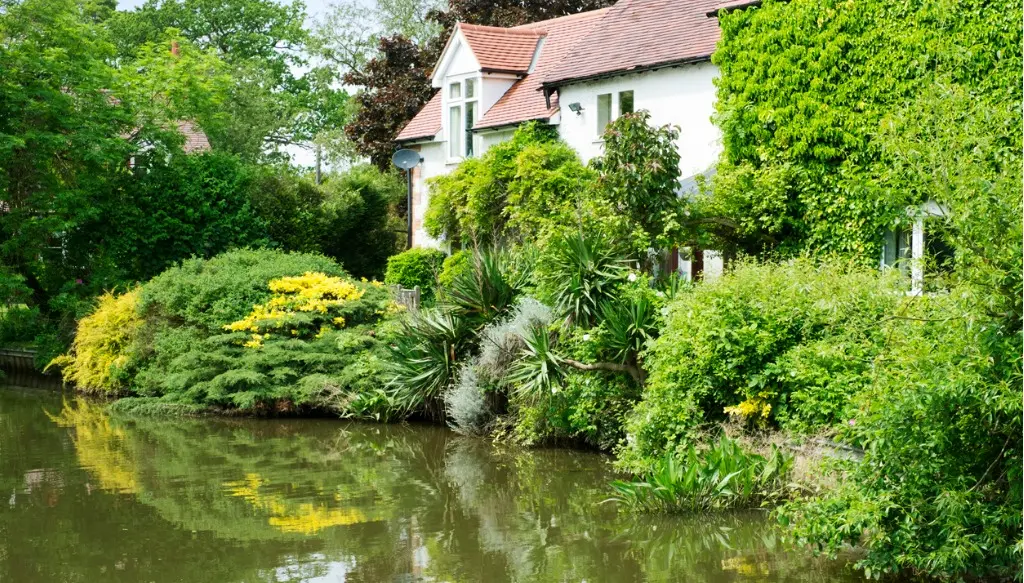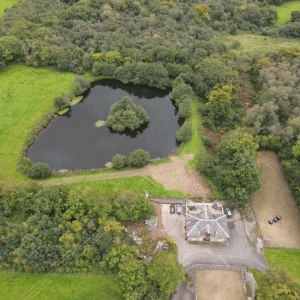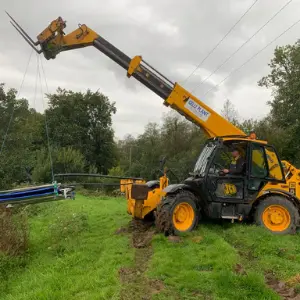Water Source Heat Pumps
The most efficient heat pump technology available. Extract renewable heat from lakes, rivers, or boreholes for year-round heating, cooling, and hot water with up to 500% efficiency.

Water Source Heat Pumps
The most efficient heat pump technology available. Extract renewable heat from lakes, rivers, or boreholes for year-round heating, cooling, and hot water with up to 500% efficiency.

Why Choose Water Source?
The ultimate choice for maximum efficiency when you have access to water
Highest Efficiency
5-6kW of heat for every 1kW of electricity. The most efficient heat pump technology available.
Heating & Cooling
Year-round climate control with both active heating and passive cooling capabilities.
Minimal Groundwork
Less disruption than ground source systems. Collectors are submerged in water, not buried.
Silent Operation
No outdoor fan means virtually silent operation. Perfect for peaceful environments.
100+ Year Collectors
Lake collectors can last over 100 years. Heat pumps last 20+ years with minimal maintenance.
£7,500 BUS Grant
Eligible for the Boiler Upgrade Scheme. We handle all the paperwork for you.
Why Choose Water Source?
The ultimate choice for maximum efficiency when you have access to water
Highest Efficiency
5-6kW of heat for every 1kW of electricity. The most efficient heat pump technology available.
Heating & Cooling
Year-round climate control with both active heating and passive cooling capabilities.
Minimal Groundwork
Less disruption than ground source systems. Collectors are submerged in water, not buried.
Silent Operation
No outdoor fan means virtually silent operation. Perfect for peaceful environments.
100+ Year Collectors
Lake collectors can last over 100 years. Heat pumps last 20+ years with minimal maintenance.
£7,500 BUS Grant
Eligible for the Boiler Upgrade Scheme. We handle all the paperwork for you.

How Water Source Heat Pumps Work
Water source heat pumps extract heat from lakes, rivers, streams, or boreholes. Water maintains a more consistent temperature than air, providing superior efficiency year-round.
Collectors absorb heat from water
Submerged collectors (lake mats or pond coils) extract warmth from the water source
Heat pump amplifies temperature
The compressor raises the temperature to usable levels for heating
Heat distributed throughout home
Warm water flows to radiators, underfloor heating, or hot water cylinder

How Water Source Heat Pumps Work
Water source heat pumps extract heat from lakes, rivers, streams, or boreholes. Water maintains a more consistent temperature than air, providing superior efficiency year-round.
Collectors absorb heat from water
Submerged collectors (lake mats or pond coils) extract warmth from the water source
Heat pump amplifies temperature
The compressor raises the temperature to usable levels for heating
Heat distributed throughout home
Warm water flows to radiators, underfloor heating, or hot water cylinder
Water Source Options
Choose the best solution for your property
Open Loop System
Water is extracted from the source, passes through the heat pump, then returned downstream. Higher efficiency but requires water quality management.
Lake Collector (Closed)
Pipe mats are submerged at the bottom of lakes or large ponds. Constructed on land then floated out and sunk with weights.
Pond Mat (Slinky Coils)
Coiled pipes attached to a stainless-steel frame. Compact design ideal for smaller water sources where space is limited.
Water Source Options
Choose the best solution for your property
Open Loop System
Water is extracted from the source, passes through the heat pump, then returned downstream. Higher efficiency but requires water quality management.
Lake Collector (Closed)
Pipe mats are submerged at the bottom of lakes or large ponds. Constructed on land then floated out and sunk with weights.
Pond Mat (Slinky Coils)
Coiled pipes attached to a stainless-steel frame. Compact design ideal for smaller water sources where space is limited.
Is a Water Source Heat Pump Right for My Property?
Water source is ideal if you have access to a suitable water body and want the highest efficiency possible. Consider these factors:

Is a Water Source Heat Pump Right for My Property?
Water source is ideal if you have access to a suitable water body and want the highest efficiency possible. Consider these factors:

Heat Pump Comparison
Which heat pump is right for you?
| Feature | Water Source | Ground Source | Air Source |
|---|---|---|---|
| Efficiency (COP) | 5-6 ⭐ | 4-5 | 3-4 |
| Collector Lifespan | 100+ years ⭐ | 100+ years | N/A |
| Installation Disruption | Minimal ⭐ | Significant | Minimal |
| Cooling Capability | Active & Passive ⭐ | Active & Passive | Active Only |
| Noise Level | Silent ⭐ | Silent | Low (outdoor fan) |
| Requires Water Access | Yes | No ⭐ | No ⭐ |
| BUS Grant | £7,500 ✓ | £7,500 ✓ | £7,500 ✓ |
Heat Pump Comparison
Which heat pump is right for you?
| Feature | Water Source | Ground Source | Air Source |
|---|---|---|---|
| Efficiency (COP) | 5-6 ⭐ | 4-5 | 3-4 |
| Collector Lifespan | 100+ years ⭐ | 100+ years | N/A |
| Installation Disruption | Minimal ⭐ | Significant | Minimal |
| Cooling Capability | Active & Passive ⭐ | Active & Passive | Active Only |
| Noise Level | Silent ⭐ | Silent | Low (outdoor fan) |
| Requires Water Access | Yes | No ⭐ | No ⭐ |
| BUS Grant | £7,500 ✓ | £7,500 ✓ | £7,500 ✓ |
Claim £7,500 with the Boiler Upgrade Scheme
If you own your home and are replacing a gas or oil boiler, you may qualify for £7,500 in government funding towards your water source heat pump installation. We handle all the paperwork for you.
Claim £7,500 with the Boiler Upgrade Scheme
If you own your home and are replacing a gas or oil boiler, you may qualify for £7,500 in government funding towards your water source heat pump installation. We handle all the paperwork for you.
Frequently Asked Questions
Everything you need to know about water source heat pumps
What water sources can be used with a heat pump? +
Do I need a licence to use water from a river or lake? +
What's the difference between open and closed loop systems? +
How efficient are water source heat pumps? +
How much does a water source heat pump system cost? +
Can water source heat pumps provide cooling? +
Frequently Asked Questions
Everything you need to know about water source heat pumps
What water sources can be used with a heat pump? +
Do I need a licence to use water from a river or lake? +
What's the difference between open and closed loop systems? +
How efficient are water source heat pumps? +
How much does a water source heat pump system cost? +
Can water source heat pumps provide cooling? +
Ready to Switch to Water Source?
Get your free estimate in 5 minutes or speak to our team about the best solution for your property.
MCS Certified • 20 Years Experience • £7,500 Grant Available
Ready to Switch to Water Source?
Get your free estimate in 5 minutes or speak to our team about the best solution for your property.
MCS Certified • 20 Years Experience • £7,500 Grant Available